Photographs: Reuters Indivjal Dhasmana and Pranjal Bhuyan
The inflation devil returned to haunt the government struggling to steer the country towards a high growth trajectory, but most of all higher prices of edibles ranging from egg to milk and fruits to onions in 2010 ruined even the most unrefined palate.
The severity of inflation could be gauged only when the prices of onion, which shot up to Rs 70-80 a kg, is juxtaposed with the average daily wages of India's nearly 300 million informal sector workers -- Rs 100.
Though statistically, onion and garlic prices account for only a small percentage of total inflation (0.177 and 0.06 per cent), the question roiling the common man would be -- what is the use of declining inflation numbers, if one cannot get a commodity as essential as onion at an affordable price.
Prices of some bulb vegetables -- onion and garlic -- went through the roof towards the end of 2010, spoiling all the gung-ho about moderating inflation and self-pat on the back by the government for controlling prices.
Incidentally, the news of onion prices skyrocketing to Rs 70-80 a kg in retail markets came at a time when the prime minister exuded confidence that inflation will come down to 5.5 per cent by March end from 7.48 per cent in November.
Onions turned extremely costlier due to damage of crops in Maharashtra because of unseasonal rains and hoarding. With government swinging into action by banning onion exports and removing customs and countervailing duties on the commodity, the prices calmed down to Rs 40-50 a kg, but garlic prices flared up and are ruling at about Rs 300 a kg.
. . .
How high prices spoilt common man's party in 2010
Photographs: Reuters
Though statistically, onion and garlic prices form only small percentage of total inflation (0.177 and 0.06 per cent), the common man is going to ask -- what is the use of declining inflation numbers, if he cannot get as essential a commodity as onion at affordable price.
The extent of high prices could also be gauged from the fact that the Union government has recently proposed minimum wage of Rs 100 for unskilled workers. Suppose these workers get this much wage only, much of it would be shelled out in buying onions, garlic, tomatoes, whose prices also rose to Rs 35-40 a kg.
Similarly, rural folks get at least Rs 100 a day with a minimum guarantee of work for 100 days a year under the UPA's flagship programme NREGA.
High onion prices had played a role in the defeat of Janata Party in the 1980 general elections and the rout of BJP in the Delhi assembly elections in 1998.
As of December 18, food inflation was at a high of 14.44 per cent.
The decline in headline inflation to 7.48 per cent in November from its peak of over 11 per cent earlier this year, however, brings no respite to the government or the RBI given the uncertainty over future prices, particularly global oil rates.
. . .
How high prices spoilt common man's party in 2010
Photographs: Reuters
In fact, the RBI in its recent review of monetary policy clearly stated that inflation remains its major concern, even though it refrained from hiking policy rates as the system was facing cash crunch. The RBI had raised key policy rates six times in 2010 to combat inflation.
A tighter monetary policy has implications for growth, as credit needed for investments would be hard to come by and may hit the government's attempt to put the economy on a nine per cent-plus growth path.
A normal monsoon and good kharif crop was expected to have brought respite on the food prices front. The government and senior economists had predicted such an outcome.
Besides bulb vegetables, protein-based items like egg, fish, meat and milk, continue to be a matter of concern. The high food prices prompted the Cabinet Committee on Prices to hold a meeting under the chairmanship of Prime Minister Manmohan Singh to take stock of the situation on December 30.
The high-level committee noted that fruits, eggs, meat, fish, milk, onions and other vegetables remained major areas of concern, a source said.
The RBI also said that there is risk of rising global commodity prices spilling into domestic inflation and warned that rising domestic input costs for the manufacturing sector, combined with aggregate demand pressures, could weigh on inflation.
. . .
How high prices spoilt common man's party in 2010
Photographs: Reuters
As regards fuel inflation, it has also registered 12.5 percent in the first eight months of the current fiscal as against a negative growth in the corresponding period of the previous year.
In the Mid-year Economic survey released in early December, the government exuded confidence that inflation will be down to 6 per cent by March 2011.
Prime Minister Manmohan Singh had said the government expects inflation to plummet to 5.5 per cent by end of the fiscal.
However, international commodity prices might play havoc and the Reserve Bank, in its second mid-quarterly review, also pointed at this. A severe winter in Europe has led to crude prices going up to almost $95 per barrel.
The RBI had fixed a target of 5.5 per cent inflation by March 2011.
In January, the wholesale price inflation was 8.56 per cent and it hovered above that figure for rest of the year, including in double-digit for six months between February and July, before sliding back of 7.48 per cent (provisional) in November, the last month for which data is available.
. . .
How high prices spoilt common man's party in 2010
Photographs: Reuters
During the year, the government also came up with a new index for measuring inflation with 2004-05 as the base year, in place of the older 1993-94 index.
The government, however, missed its target of bringing down WPI to 6 per cent by March 2010. In fact, it crossed the 10 per cent psychological barrier in February and remained in double digits till July.
In April, inflation touched a high of 11.23 per cent. The downward trend of inflation began only after introduction of the new series in August.
That month, inflation fell to 8.82 per cent. In September it again inched up to 8.93 per cent. The provisional figures for October and November show inflation at 8.58 per cent and 7.48 per cent, respectively.
Many experts, including Planning Commission deputy chairman Montek Singh Ahluwalia, had projected the rate of price increase to fall and inflation to come down to 6 per cent by December.
It seems highly unlikely to happen, though the provisional numbers for December will be released only in the New Year.
. . .
How high prices spoilt common man's party in 2010
Photographs: Reuters
Among the many segments in WPI, food is the one which is of daily concern to individuals and households.
And this is one segment which showed a downward trend for some time, albeit not as much as the consumers would have loved.
From a high of over 17 per cent in the beginning of January, food inflation fell to below 9 per cent in late November, before inching up to 9.46 per cent for the week ended December 4.
However, onion and milk prices again catapulted it to double digits of 12.13 during the week ended December 11 and again together with non-vegetarian items fuelled it further to 14.44 per cent for the week ending December 18.
For most of the year, food inflation was in double digits. The only exceptions were a fortnight in July and again two weeks in November.
The lowest it plunged in 2010 was for the week ended November 20 when in was 8.60 per cent.
. . .
How high prices spoilt common man's party in 2010
Photographs: Reuters
Despite onion and a few other vegetables turning hugely expensive as the year draws to a conclusion, experts are optimistic that it will stabilise further and continue to be low till at least May 2011.
The monsoon has been good in 2010, unlike the deficit last year, and kharif crops have been sufficient, except for loss to onions in parts of Maharashtra due to post-monsoon unseasonal showers.
Agriculture and allied activities grew by 4.4 per cent in the second quarter of this fiscal from 0.9 per cent a year ago.
This and prospects of better crops in the Rabi season is expected to ease inflation.
In fact, consultant Dun & Bradstreet projected inflation to average just 4 per cent in 2011.
If it does not happen, RBI and the government will be staring at a dilemma -- to either tackle inflation or promote growth -- as there are uncertainties that may hit economic expansion despite 8.9 per cent growth in the first half of this fiscal.

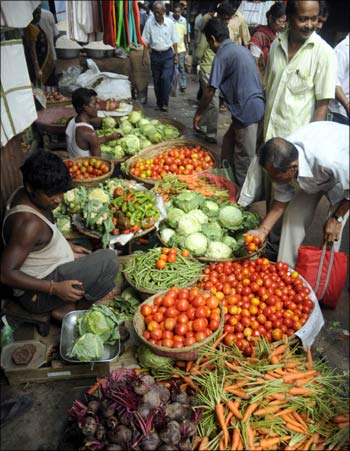


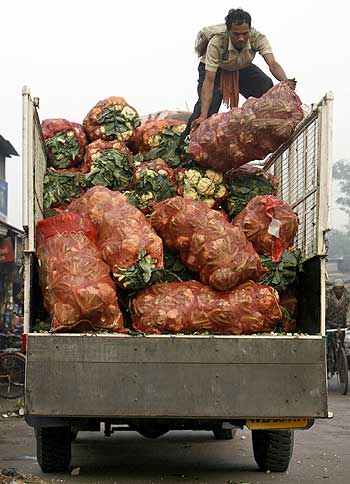
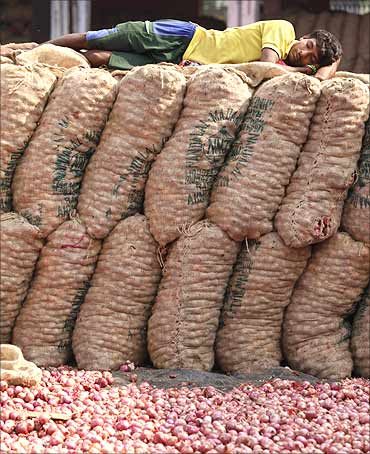
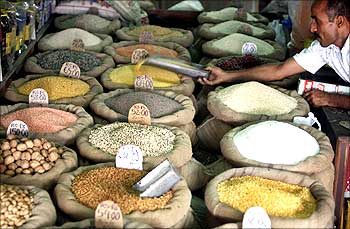
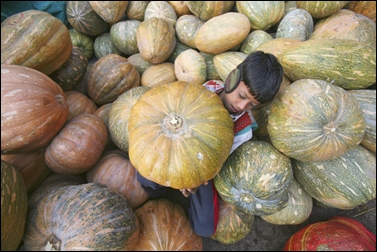
article